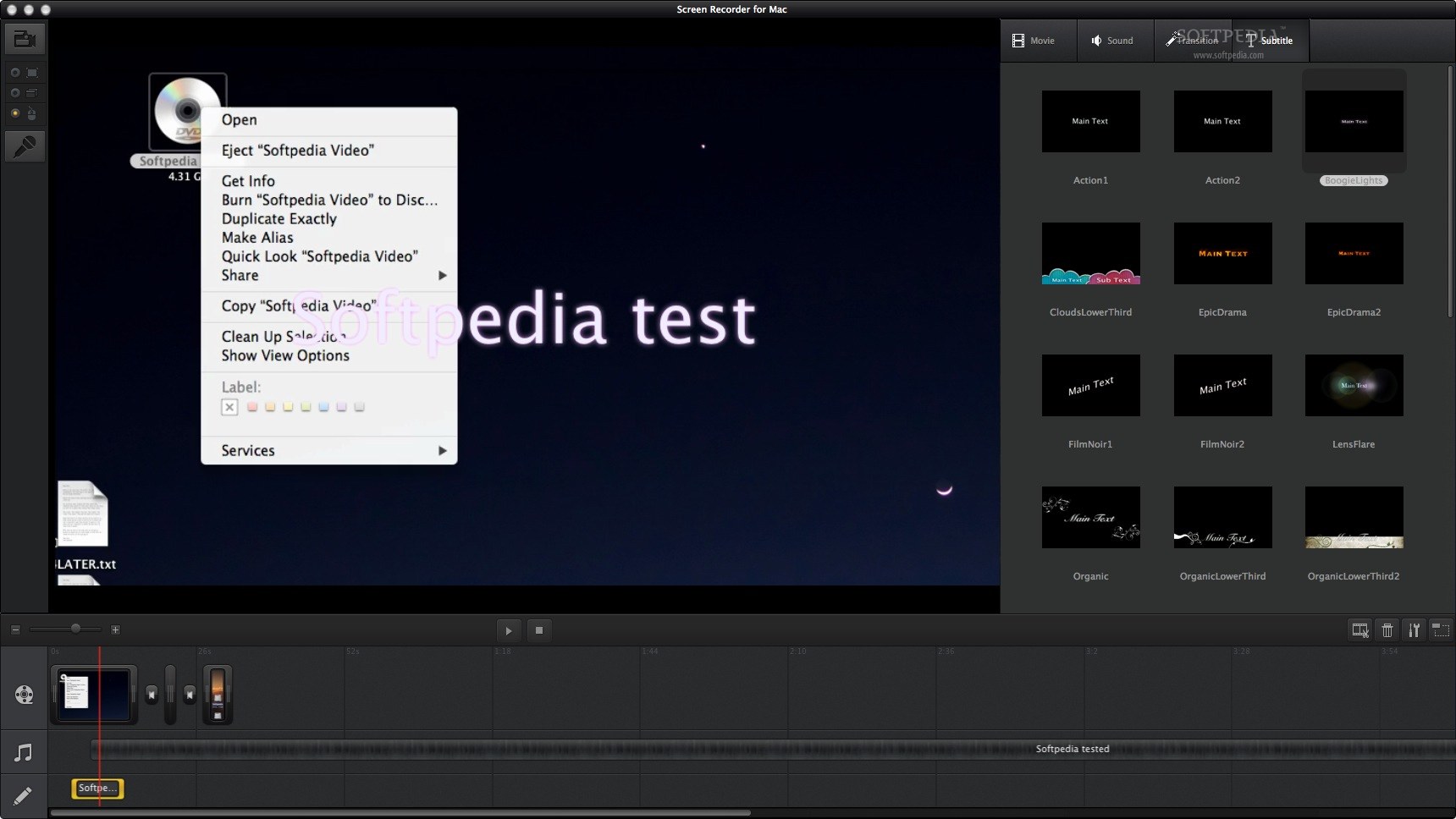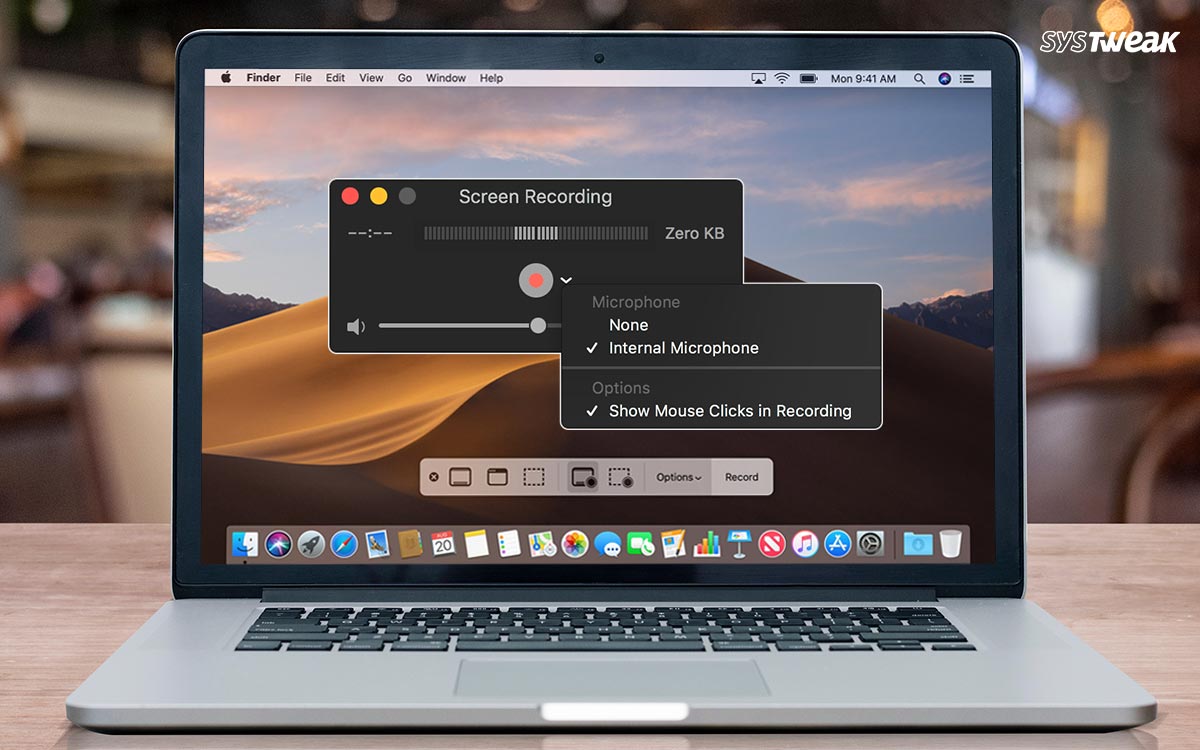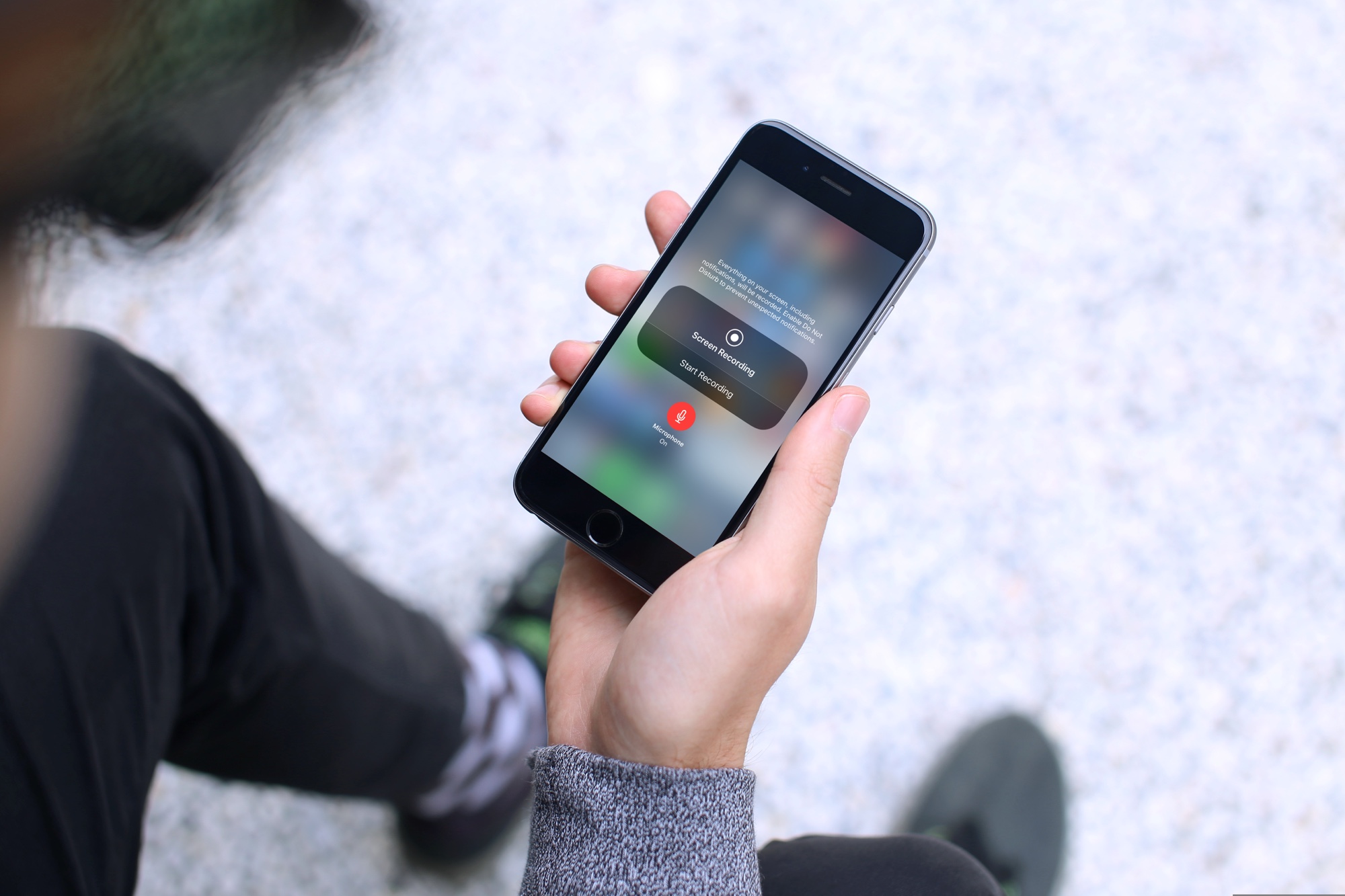If you’re planning to record audio on a professional level, like for a podcast, movie or music production, audiobooks, or even making a YouTube tutorials, you could even connect an external microphone and use that as an audio source. Do you use a Mac? If so, you might be interested in recording the screen of your MacBook or iMac too. When you click it, the recording stops and you get a brief glimpse of a thumbnail-sized image at the bottom right of your Mac's screen. Click on that and you can do the same markups and sharing of.
- Luckily, there’s a QuickTime Player X app for all versions of macOS till Mojave to record screens on Mac. Using it, you can record both screen and video on Mac with sound. To record screen on Mac using QuickTime Player X, head to Applications, click File New Screen Recording.
- The screen audio recording limitation of QuickTime paves the way for both third-party virtual audio driver and Mac screen recorder with audio. In other words, you have 2 ways to achieve a regular screen.

To record Mac screen, you can use QuickTime screen recording. But if you need to record internal audio on Mac as well, QuickTime player is not good enough as the built-in recorder can only record the audio through external speakers and built-in microphone. Here we will introduce you two ways to record screen and audio at the same time on Mac. You can capture screen video with sound, including the system audio and voiceover.
You May Like:
Top 5 Screen Recording Software for Mac
Method 1: Screen Recorder with Audio for Mac
Since QuickTime cannot record internal audio without the help of a third-party application, why not replace QuickTime with a better Mac screen recorder?
FonePaw Screen Recorder can work as a great alternative for QuickTime. As a professional recorder for iMac, MacBook, the Screen Recorder is much more powerful than QuickTime.
Record screen along with the internal audio of your Mac;
Record Mac Screen with voiceover from the microphone;
Capture your screen with the webcam;
Add notes to the recorded video;
No extra application needed.
To record your own video on Mac, get started here.
Step 1: Download and install FonePaw Screen Recorder for Mac. Then you can use the trial version to record 3-minute video or audio.
Step 2: Please customize the region that you want to capture, turn on/off the microphone, adjust the volume, and set up hotkeys, etc. When you get ready for recording, click the REC button.
Step 3: Your Mac screen is being captured so you can do anything that you tend to show in the recordings. Besides, you can turn on the webcam to put yourself into the video.

Step 4: As all things have been recorded, just hit the REC button again to stop capturing or use the hotkeys. Then, the video with audio that you have captured will be saved automatically. You can preview it and share to Facebook/twitter.
Video Guide: Record Screen Activity with Audio on Mac
Method 2: QuickTime to Record Screen Video with Audio on Mac
1. Begin QuickTime Screen Recording
Step 1 On your iMac, MacBook, use Finder to find QuickTime player and launch the program.
Step 2 Click File on the top menubar and choose New Screen Recording.

2. Choose Audio Sources for Screen Video
Step 1 On the Screen Recording box, click the down arrow icon next to the record button.
Step 2 On the drop-down menu. You can choose record audio from the internal microphone or an external microphone. If you don't need a high quality of sound, you may just record screen with audio from Mac's microphone.
Step 3 Click the red record button to start capturing the Mac screen with sound.
Note: To record system audio on Mac, you can use Soundflower with QuickTime screen recording. Soundflower is an audio system extension that allows an application to pass audio to another application. For example, you can select Soundflower as the output device for YouTube and choose Soundflower as the input device for YouTube. QuickTime will be able to record both screen and video of the YouTube streaming video on Mac.
3. Stop QuickTime Screen Recording
When you have captured everything you need with your Mac screen, you can click the record button again to stop the QuickTime screen recording. Or you can right-click on the QuickTime in the Dock and select Stop Recording.
Note: Some users reported that Soundflower doesn't work on Mac OS Sierra. If this problem is happening on your Mac, get a professional screen recorder for Mac.
Method 3: Mirror Mac Screen to Windows and Capture its Activities
There is another tool called FonePaw ScreenMo to capture your Mac screen. It can mirror Mac screen to Windows PC monitor; project multiple device screens, e.g. the screens of MacBook, iPhone, iPad, to the same PC screen; then record the Mac desktop activities on Windows computer.
Download
1. Airplay Mac Screen to PC
Step 1 Download FonePaw ScreenMo on PC and launch the program.
Step 2 Put your iMac/MacBook and a Windows PC on the same Wi-Fi.
Step 3 On the top menubar of Mac, click the Airplay icon and choose the Airplay name of iOS Screen Recorder. The Mac screen will be presented on the PC.
2. Record Screen and Audio at the Same Time on Mac
Video Screen Recording On Mac
Step 1 On the main window of iOS Screen recorder, tick 'add an extra lossless quality audio-only Airplay receiver' under Advanced Setting, which allows you to record Mac screen video with high quality of sound.
Step 2Click the record button to begin recording the Mac screen. Make sure you have enabled the microphone.
Step 3 When you have done recording, click the record button again.
Step 4 A window will pop up, click Start Export to save the Mac screen video on the PC.
Now you can use these methods to record streaming video, streaming audio, Skype video call, etc. on Mac. Enjoy!
Have you wondered how to record your screen on a Mac? How to screen record on a Mac with sound? Perhaps you want to record tutorials for software you like, make software reviews, or record yourself playing video games. How do you do it? There are some key things you should know before you pick the right software to do it.
How to screen record on Mac with audio:
- Launch Screenflick
- Click 'Record System Audio' to capture the sound playing on your Mac
- Click 'Record Microphone' to record your voice
- Click 'Record Camera' to record your FaceTime camera
- Select the area of the screen (or full screen) to record
- Start the Recording!
Some of the great features of Screenflick
- High Performance Recording
- Record System Audio
- Record Microphone Audio
- Record Video Camera
- Hide the Mouse Cursor
- Mouse & Keyboard Display
- Record High Resolution Screens
- Recording Scale & Frame Rate
- Cursor-Following Modes
- Create Timelapses
- Flexible Export Options
- Draw on Your Screen
Whatever it is you want to record, Screenflick is a great tool to get it done.
Quick Contents:
Screenflick - A Better & Faster Mac Screen Recorder
Unlike QuickTime Player, Screenflick is a real screen recording application for your Mac which has a wealth of features to control the recording and exporting, while being well-known as easy to use. With Screenflick you can record smooth high quality recordings of your Mac's screen with system audio, microphone audio, and even picture-in-picture from a video camera. Screenflick can optionally display mouse clicks and keyboard keypresses, add an emblem/watermark image to the recording, and offers plenty of control over recording and exporting settings so you can use it to do exactly what you want.
Using Screenflick to Record Your Mac Screen
- Open Screenflick
- Optionally change any of the recording settings to suit your needs
- Click the recording button
- Select the area of the screen to record and start recording
- Stop the recording when you're done
- Optionally change any of the export settings to suit your needs
- Export the recording
If you don't need or want to change any settings, it's as simple as it gets to use, but because you can customize many settings, it's much more useful and powerful. See more about how to use Screenflick.
Some of the great features of Screenflick
Mac Screen Recording No Audio
- High Performance Recording — Because Screenflick doesn't record directly to an H.264-encoded movie file, it has great performance allowing you to record high resolutions at high frame rates, and at higher quality than H.264 movies typically allow. Record full screen games up to 60 fps.
- Record System Audio — Built-in support for one-click system audio recording. Record the audio from games and other applications.
- Record Microphone Audio — Record the built-in microphone or any other mic plugged into your Mac.
- Record Video Camera — For example, record your Mac's built-in FaceTime camera to create a picture-in-picture overlay
- Hide the Mouse Cursor — Don't want the cursor shown? Hide it so it's not in the recording at all.
- Mouse & Keyboard Display — Optional display of mouse clicks and keyboard keypresses with customizable styling.
- Record High Resolution Screens — Record even large Retina screens, with high frame rates, both at Retina and non-Retina scales.
- Recording Scale & Frame Rate — Customize the scale and frame rate for extra precise control over performance. (For example, using a 720p recording scale on a 15' MacBook Pro improves performance by 80% over QuickTime Player. That means more of your computer's power is saved for what you're recording, instead of using that power just trying to record it.)
- Cursor-Following Modes — With Screenflick, you can choose to record a small-sized area around the cursor, and it'll follow the cursor everywhere on your screen. Perfect for recording application demos and tutorials on large screens.
- Create Timelapses — In Screenflick you can control the frame rate of the recording and the time scaling of the movie. This means you can set to record at a low frame rate, such as 3 frames per second, record yourself for an hour, speed up the recording by 10x and create a wonderfully smooth 6 minute timelapse, all while using very little energy/processing time (battery life!) during the recording itself.
- Flexible Export Options — Choose amongst file formats, video compression options, audio compression options, target ProRes files for highest quality imports into iMovie and Final Cut, control exported dimensions, frame rate, and time scaling of the movie file and more.
QuickTime Player – Not The Best
QuickTime Player is an application from Apple that comes with every Mac. You've probably already used it when watching different movie files or listening to audio files that are on your Mac. Well, not only can QuickTime Player watch video and audio files, but it can create them too, including screen recording movies. Using QuickTime Player to record your screen is simple:
- Open QuickTime Player
- Choose File -> New Screen Recording from the menubar
- Click on the record button in the window
- Select which area of the screen to record (full screen, or just part of it)
And off you go. To stop the recording, click on the stop button in the menubar. After that, you can save the file, share it on YouTube, import into iMovie, etc. Whatever you want.
Why QuickTime Player Isn't the Best Choice

QuickTime Player is free, is already on your Mac, and is simple. It's great, but unfortunately it's also a bit limited in several ways. Here are just some of the ways QuickTime Player doesn't live up to most uses:
- No System Audio — Any of the audio playing on your Mac isn't recorded. QuickTime Player can record your microphone and your video camera, but there's no built-in way for it to capture any of the audio playing in movies, games, or any other software running on your Mac.
- Low Performance — QuickTime Player uses real-time encoding to H.264. In plain English, this means it creates a final movie file that's ready immediately when you stop the recording. That's useful, but unfortunately H.264 is really difficult for computers to encode, so most Macs simply can't keep up; especially when recording full screen. At large resolutions, the amount of data your computer needs to compress to create a final movie file in real-time is extremely demanding. So as an example, QuickTime Player (or any other software using real-time H.264 encoding) on even the highest end Macs will have difficulty with recording full screen games with it leaving you with a low frame rate movie file which will look very 'stuttery' or 'laggy.' QuickTime Player is not good for recording games.
- Poor Quality Control — Not only does the real-time H.264 encoding have an impact on performance, but it has one on quality too. H.264 movies naturally have reduced quality as part of the compression scheme to make the file size small. That compression means the file is already lower quality – quite possibly lower than you want, especially if you're going to import it into a movie editor like iMovie or Final Cut, which then will cause further quality loss. QuickTime Player does let you pick a 'maximum quality' mode, but then the file sizes of the recordings are enormous, requiring huge amounts of disk space which is impractical for large recordings.
- Mouse & Keyboard Display — Seeing what's on screen is only part of what viewers may need to see in your recordings. Very often it's useful to see when the mouse is being clicked, which button is clicked, which keyboard key-combinations are pressed for shortcuts, etcetera. QuickTime Player can show mouse clicks, but only as a brief flash of an ugly plain black circle; It can't show which button was clicked, modifiers held during the click, or keyboard keypresses at all.
- No Cursor Following — If you want to record just a small area of the screen, QuickTime Player is locked into recording only that one small area, and nothing outside of it. A good screen recorder offers the capability to record a small-sized area that follows the mouse cursor around, so you can still use the entire screen, and capture everything you're doing on it. This is tremendously useful, and QuickTime Player can't do it.
- No Timelapses — If you're an artist wanting to capture a timelapse recording of yourself creating digital artwork, forget about using QuickTime Player because it simply can't do it. Not only can you not control the recording settings so that it's not wasting tons of energy and processing time recording data that won't be used anyway, but QuickTime Player also can't speed up the recording anyway.
- Few Export Options — QuickTime Player is severely limited in how it can save files. Your choices are limited to a single movie file format, no control over the audio, and you can only export with the dimensions it already it is in, or 1080p or 720p. That's it. No specifying custom dimensions, no scaling by percentage, no control over aspect ratios, no choice over the quality of the exported file… none of that.
- And many more limitations…
While QuickTime Player is very simple to use, its simplicity also makes it useless except for the simplest of purposes. In summary, it's good for capturing a small area of the screen, with no system audio, for a short duration of time, where you want no control over the size, quality, or format of the result. Beyond that, it's not what you want.
QuickTime Player is Okay for:
- Capturing a small area of the screen, for a short duration, without any system audio
QuickTime Player is Bad for:
- Games
- Application tutorials
- Professionals
- Artist timelapses
- Pretty much everything
Conclusion
Screenflick offers far more features, flexibility, and performance better than QuickTime Player, while still being really easy to use. There's a reason that Screenflick is a very popular screen recording tool used by everyone from 8 year-old YouTubers, gamers, software developers, and professional software trainers. Whatever it is you want to record, Screenflick is a great tool to get it done.